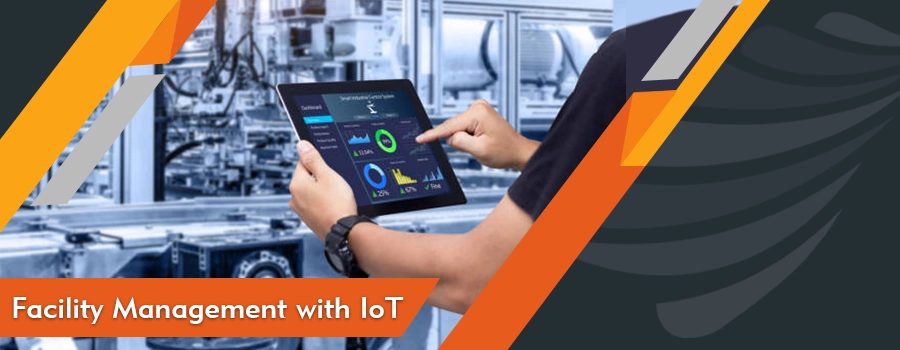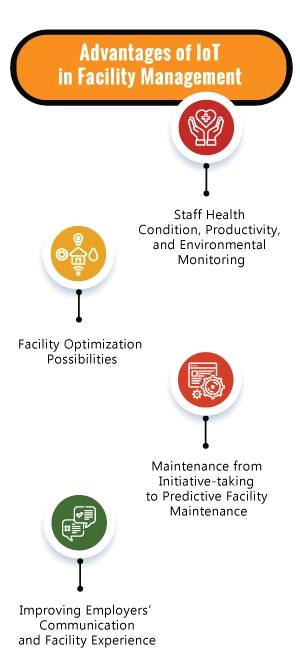Restructuring the Facility Solutions
Developing integrating monitoring systems into facilities for continuous supervision for seamless operations. To have the utmost control, designing flexible and upgraded facility management; IoT has supplied facility managers slew of solutions.
Managing a facility is no child’s play – encircling a plethora of responsibilities, no matter the industry. There are numerous challenges that facility managers face on a day-to-day basis – gaining high-level customer satisfaction and appraisals, overseeing documentation procedures, inventory assemblage, and at the same ensuring maximum profits. This is the part where IoT outshines all the rest of facility management technologies.
Competition is the part of every industry – the same is the case with facilities, which industry will be good at easing its customer with impeccable services and ensure flawless operations results in superlative profits and earnings. IoT enables managers to delegate tasks accordingly to employees which will enhance production capabilities, improve customer satisfaction, balance assignment of the task to the workforce, etc.
Practical Approach and Applications of IoT in Facility Management
With the increase of IoT integration in approximately every industry, suffice to say that IoT in Facility Management is “astute”, simple in all: deployment, implementations and usage, and cost-effective. The “Smart Building Management System” is a legacy concept – IoT has evolved building management to another level. Boosting the intelligence of your legacy system will help you in staying at the top of the game.
The difference between the legacy system of building management and Facility management provided by IoT Lis humungous – whereas before IoT there were not many options of what managers can do with building’s management: managing various systems in a facility is what legacy system provided, with IoT managers have real-time access of facilities operations and monitoring, systems in a facility are only called when they are needed, and control on different areas of a building is completely remote and whole.
IoT in Facility Management has various practical applications
 Cooling Sensors:
Cooling Sensors:
In every facility, cooling sensors play a key role – they allow every HVAC compressor unit to send information that encompasses the demand for load with each other. With this, every unit performs efficiently, has the perfect ability, and conserves energy by running a single unit until demand arises for another unit.
Temperature Supervision:
IoT has uncountable benefits, one of them is temperature monitoring and supervision. Temperature monitoring can be carried out in more than one location. Temperature sensors are quite sophisticated and intelligent – if there is an area that is warm compared to others; sensors will guide air conditioning vents to supply more cool air in the specified area. Temperature sensors are an absolute necessity in places where food, vaccinations, or medicines are stored. Lack of temperature supervision in those areas can cost greater amounts of risk such as soiled medications or spoilt food.
Condition Supervision and Predictive Monitoring:
Like the rest of IoT-based sensors, these condition supervision and predictive monitoring sensors checking facility systems, pieces of equipment, and supplying real-time data informatics about their performances and efficiency. Furthermore, real-time information on parameters such as air and oil pressures, power usages and optimization, vibrations, heating’s, etc.
Daytime Sensors:
Saving extra dollars is never harmful – a company that is intelligent in knowing where and how much to use their resources has reached the apex of success. After temperature controls, lighting controls on another most basis and significant sensor. Detecting levels of sunlight coming in the facility, sensors adjust and used the required number of lights, turning off the remaining throughout the facility.
Advantages of IoT in Facility Management
Far more than just a “fashionable idea”; IoT something powerful and useful. Implemented in approximately every sphere of every industry, IoT is presenting us with Smart environments that assist us is supervising all operations of an industry.
A technology which is commonly known to provide with valuable information such as cost-effectiveness is Facilities, the performance of both: workforce and machines, efficiency and optimization of machines; few benefits of IoT in Facility Management are

Staff Health Condition, Productivity, and Environmental Monitoring:
Sensors are not merely made for real-time data only. The infrastructure of every sensor goes future than services, space optimization, and real-time data diagnoses. With sensors, we can gather value able data such as levels of Carbon Dioxide (CO2), Lights, Volatile Organic Compounds (VOC), Temperature, Humidity, etc. These factors play a vital role in staff health and productivity.
Another advantage of these sensors is the sign they show when a “break” from a meeting is needed – levels of CO2 increase in meeting rooms, thus these indicators help in breaks and when to open windows to let the fresh air in the room.
Facility Optimization Possibilities:
IoT-based sensors framework empowers facilities that unravel space optimizations. These sensors supply data as to how to use space, when is the space vacant, for how long, the traffic influx on a particular area, and when more space is needed. These managements across the facility help managers manage space and use them to its maximum potential.
Maintenance from Initiative-taking to Predictive Facility Maintenance:
IoT sensors and the data gathered from them feed into existing assets. With the feet entered the system helps managers and supervisors to have real-time diagnostic ability to detect fault detection and advance operations. IoT for asset management in Facility providing with both: remote and centralized monitoring the assets in the facility for maintenance.
Furthermore, with prior fault detection, managers ensure seamless operations. For a business to get unscheduled maintenance due to any detection, customers’ orders will face delays, hence resulting in a bad reputation. With these sensors, prompt maintenance guarantees consistent machine operations.
Improving Employers Communications and Facility Experience:
There are various kinds of sensors available in the market; one of them is called a “Beacon.” A beacon which is a small transmitter that gathers and transmits data based on the location from connected smartphone applications – is largely being used by retailers to send more personalized data directly to their customer’s smartphones. These beacons send customized data to employees from enhanced engagement in the office, send notifications, alerts, etc.
Additionally, the beacon captures real-time data which helps managers to decide what kind of issues they’ve faced by new people coming to the Facility and proactively resolve them with the help of IoT.
In a Nutshell
The world is moving on a pace never saw before – before we know it latest smartphone becomes talk of yesterday and a new concept takes its place. People are always looking for stimulations in their everyday lives – be it in shopping experiences or in office/facility. IoT is the key to making people awe in wonder. With Facility management provided by IoT, companies can augment values, boosts profits, have cost-effectiveness, improve augmented services, magnify their services spectrum, etc. all that, in the end, helps them achieve success and unparalleled customer satisfaction. IoT for Facility Management is nothing more than an altered reality of Smart buildings in a progressively, integrated technology.


 Cooling Sensors:
Cooling Sensors:



